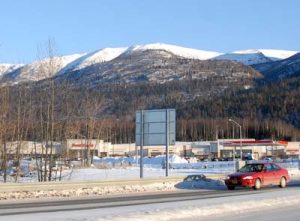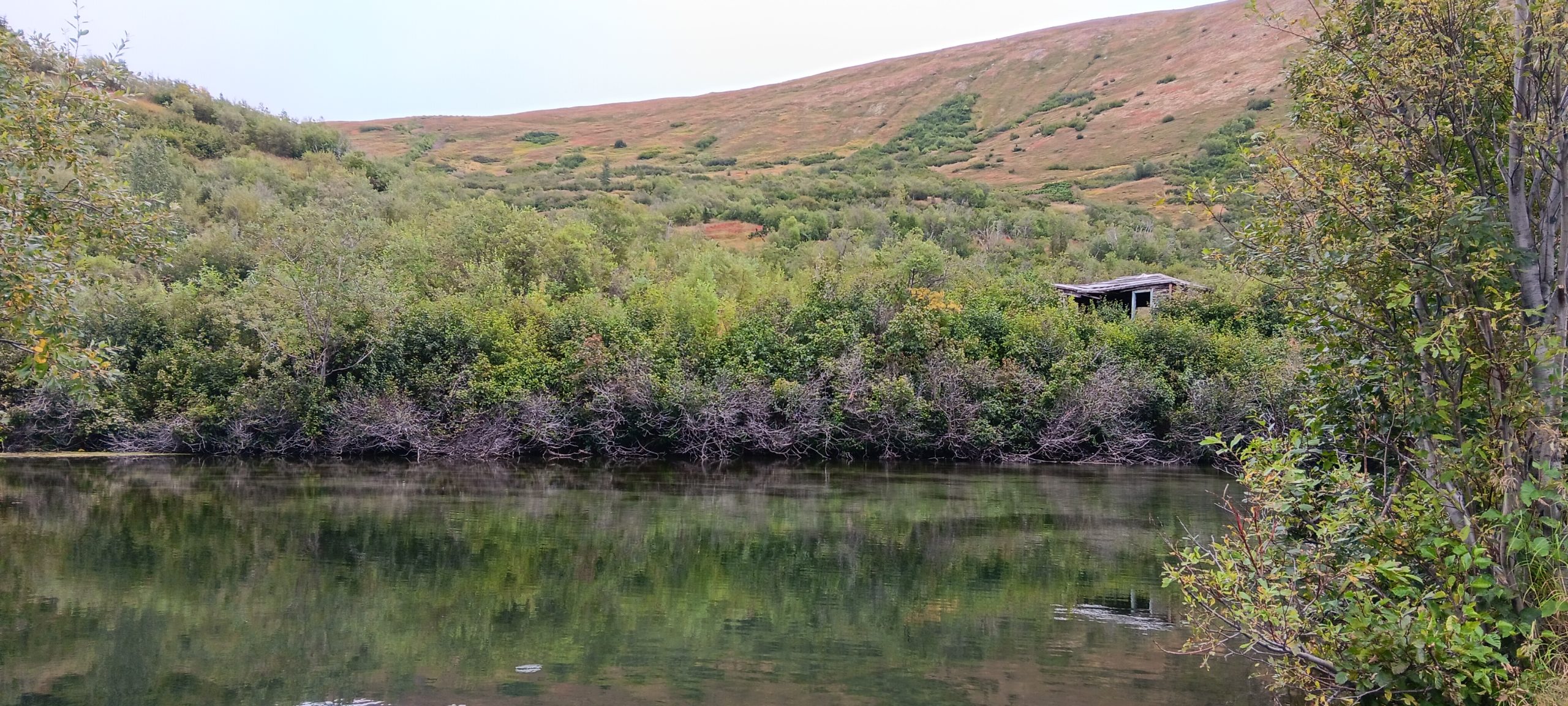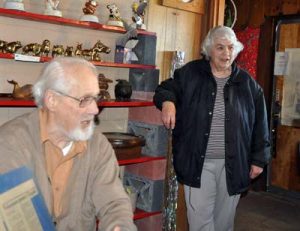14 A Chugiak Legend: How a Visionary who Could Move Mountains Helped Build a Town
Mary Lochner and Greg Hartley
About the Author
In 2011, journalist Mary Lochner interviewed the aging pioneer Til Wallace at his home in Eagle River. The interview was published in two parts by the Chugiak-Eagle Star, a newspaper formerly published in Eagle River. Two years later, Til passed away and Mary again wrote about Til, this time penning his obituary.
The article below represents my attempt to rescue an important piece of homestead history in Southcentral Alaska. Each of Lochner’s stories filled in new details but repeated certain elements due to being published separately. In preparation for this edition, I removed repetitions and revised some sentences to improve the flow into each new section, creating a full version of the Wallace legacy in a single article.

Mary Lochner’s Introduction
At the top of the road that begins as Skyline Drive in Eagle River is a place almost every local knows. It’s where couples go to drink in the view. It’s where hikers, snowboarders, skiers, and scouts gain access to the popular Mount Baldy, bypassing the private property gate that gives almost no one pause. And, it’s where many have gone to explore the mysterious ruins that lie scattered at the end of the property’s narrow old road where it curves around an artesian-fed pond. But the place’s true name is the Old Wallace Homestead. What follows is the story of the homestead’s owner, Til Wallace.
A meeting
She wore a yellow scarf. Ella, slender, beautiful brown-haired Ella, riding a bicycle through Chugiak’s main street with two friends, riding all the way from Canada because ever since she was a school girl in Switzerland, she had wanted to go to Alaska.
Thillman Wallace stood in the sun to watch her. He and his brother, Art, worked outside every day making molded concrete blocks by hand. These were the blocks that would be used to build the Moose Horn, soon to be the center of social life in Chugiak, and many other buildings in the nascent town. The year was 1956.
Thillman—or Til, as his friends and family called him—would face the wide green slope under Mount Baldy as he worked. In Germany, they had called that a berg. Home mountain. Every town had one. In Til’s worldly travels, the idea of a home mountain had stuck, and he daydreamed about making that place a homestead, a new berg for a new town.
But Ella came into view, and he watched her instead, cycling down the road.
There are men who watch all manner of muses arrive and depart in their lives, without feeling the need to follow. Inspiration, love, vision, adventure. If Til Wallace had been that kind of man, he would never have left his family estate in New York, or joined the Army, or traveled the world on foot with a small monkey on his shoulder for a companion.
As it happened, Til Wallace was a man who would feel the muse seize on him, and pursue it with open wings, taking flight without a thought for the ground behind him.
“Are you farmers?”
Ella and her two friends were just coming out of an Eagle River coffee shop and turned to look at the strange young man who chased after them.
He stopped in front of them, and seemed to say again, “Are you farmers?”
They laughed at him.
“Are we farmers?”
He tried again.
“Are you foreigners?”
After two days with Til, it was time for the girls to move on.
“Where are you going?” he asked.
They told him they were traveling toward Seward.
“Leave your yellow scarf outside of your campsite so I can find you,” he said to Ella.
She thought that was strange. The girls made camp near McHugh Creek that night. Ella kept her scarf with her in the tent.
At 3 a.m., they heard the rumble of a vehicle approaching and came out to see who was there.
It was Til. He had driven toward Seward and stopped in every campsite along the way, not finding them. On the way back, he spotted their tent and bikes.
At this time, Ella noticed one of her friends had started to take to Til, and he seemed to return her interest.
“Then I thought, oh, I better get him,” Ella said.
After that, she left her yellow scarf outside for Til to find. Every day, as they bicycled farther down the Seward Highway, he would finish work, drive out to see them, and drive back in the morning to work again.
Then, he left Chugiak behind. Ella got on a boat and made her way back to Canada; Til followed. She moved into an apartment in Seattle and found work; he found his own place there and looked for work, too.
Every day, he called her on the phone, and soon, he was asking her to marry him.
“No.”
He kept asking.
“Finally, I just said yes because I was embarrassed,” Ella said. “Each time he called, the landlady had to walk upstairs and tell me I had a phone call from him, and she was getting a little bit irritated.”
Three days later, she received a package. Linen sheets, an engagement gift from Til’s parents in New York.
They drove back to Chugiak, and the following spring she was his bride in a wedding ceremony that brought out the whole town.
“I wasn’t in love with him yet,” Ella said. “That came later.”
Home on the Range
Ella and Til spent the next few years surveying and building on the land they staked as their homestead, pulling sled loads up the mountain on foot to the berg slope of Til’s visionary daydreams. The Wallace brothers’ concrete business grew and became Klondike Concrete. Today, the wide, carved-out mountainside, with an office building surrounded by equipment and piles of assorted gravel, is a testament to the ordinary ways in which faith can, throughout the small space of a human existence, move mountains. The business has since been sold to another operator. Ella and Til’s home sits above the cliff face, a log cabin construction they shared at the end of Til’s life with a dog, a pet duck, and an extended family of squirrels.
The first cabin they built up on their homestead was burned by vandals, and the second one was, too. The couple got fed up with it, and for a few years in the 70s, Til was ready to scrap his vision for a berg, a place of paradise, and put a housing development up there.
“I had to work every day,” Til Wallace said in a 2013 interview. “I can’t sit home and watch the house to keep it from burning. So we decided, we’ll subdivide it.”
The homestead was subdivided and platted in 1973, and the Wallaces hired a well driller to tap a water source big enough to support a neighborhood. After hitting five dry holes, the guy was ready to pack up. But Wallace told him, “Heck, why don’t you just drill right here in the road?”
The contractor hit an artesian well, an unlikely find for an area that suffered from too little groundwater for miles around.

The Wallace brothers, who owned Klondike Concrete at the time, offered to pave Skyline Drive all the way to the property for the municipality, improving five miles of it on their own dime and to city standards. By 1976, everything was set for the development of a pretty new neighborhood.
But it wasn’t a good time for new development. There was a little something going around called the environmental movement. Paving roads and bulldozing nature was unpopular. And, a group of homeowners at the base of Skyline didn’t like the Wallace project. They were afraid a new neighborhood would bring more traffic past their own private pieces of nature.
Wallace was a man who had gallivanted from Australia through Europe to Alaska — with a monkey on his back. He’d built a concrete business with his family literally from his own two hands, starting out back before concrete block was made by machine. He loved nature. He’d been a homesteader and a pioneer.
But now, he was “The Man.”
“The crap hit the fan in ’76,” Wallace said. “This homeowners group got an attorney.”
Wallace got sued.
The homeowners didn’t want extra traffic going up the mountain. He and his brother did end up improving the road. But the project to develop a neighborhood got tied up in court. In the end, Wallace gave up, and in a way, both sides lost.
Wallace now had a homestead he couldn’t develop that was vulnerable to arsonists and looters. He wasn’t the only one who thought the place was paradise. And now, with the road extending up to it, he got more visitors than ever before. Instead of having a few additional family vans going up the new road, homeowners at the base saw hordes of rowdy teenagers cruising up to reach the undeveloped grassy plateau in the mountains for everything from hang gliding to hiking to partying. He’d arrive to his beloved berg to find it littered with beer bottles, cigarette butts, and once, a crashed motorcycle. He put up a gate. He didn’t mind people using the land, he said in the 2013 interview, as long as they were respectful and didn’t drive on the narrow dirt road that extended past the Mount Baldy trailhead and onto his property, making a loop around the man-made lake that formed after his driller struck that artesian well.
Where the wild horses roamed
Then, his daughter, Stephanie, wanted a horse.
She was 12 years old, and it was the early 80s. Til loved animals and was happy to get her one. Stephanie proved to be, like her mother and father, a hard worker, tending the animal with dedication and care.
Til thought he might like to get a horse, too.
Or 50.
“I thought, hell, we got the land,” Til said in 2013. His grandfather, Thillman Favry, was a German immigrant who arrived in the U.S. in 1870 and lived a ramblin’ life, spoke seven languages, spent time living in villages with various tribes, and rode horses all over the West.
“All ya gotta do is get a horse. Be just like my grandpa. Live that way. What’s stopping me?”
His daughter, Stephanie LeProwse, said it was hard work taking care of the horses, a group of 50 that roamed free across the homestead.
At the same time, Til started falling in love with historic cabins from around Alaska and hauling them up to the homestead at the top of Skyline, setting them in a circle around the man-made pond in a way that made the place look like an ancient town. Some had been built as early as 1912.
The end of an era

Wallace was living the dream. But by the early 90s, he was in his early 60s. He sold the horses, gave others away. He started wintering in his house with his wife in Chugiak, instead of up at the old ranch.
Eventually, Til sold the horses, having grown too old to care for them. The end of the road he’d paved up to his property became a popular place for locals to enjoy the view, and eventually local government expanded and paved the area for parking, and widened the trailhead up to Mount Baldy.
The place where wild horses once roamed drew residents to it. They bypassed the private property gate to hike and explore its curious buildings with inexplicable origins. Some of these were looters who dismantled the buildings for wood, or vandals who tagged the walls. Over time, other visitors—either through carelessness or maliciousness—burned the buildings down.
Now only one stands. It is a small cabin built of railroad ties, which belonged to one of the first founders of Chugiak. The roof sinks. The moss grows over it. It is the final testament to a bygone era and to the forces unleashed by the gallivanter and pioneer Til Wallace, who, with his brother Art, hand-crafted the concrete blocks used to build Chugiak’s first commercial buildings, fell in love with a mountainside, and created there one of the most unique places set down in the Last Frontier by man.
Til Wallace died in his home on March 24, 2015. His daughter, Stephanie, said he was a man who was always after adventure. “Because that’s what life is about,” she said. “It’s about adventure.”
Sources
The Chugiak-Eagle Star ceased publication in 2020. While the Star’s website is no longer active, the articles can still be accessed via The Internet Archive:
- Lochner, Mary. Old homestead atop Skyline may soon be a subdivision (February 1, 2013)
- Lochner, Mary. Where the wild horses once roamed (February 6, 2013)
- Lochner, Mary. A Chugiak legend (May 21, 2015)
young, emerging
Greek goddesses of inspiration
A park just south of Anchorage on the Seward Highway.
mapped out for roads and utilities
a shallow well that produces water under its own pressure
evil or unkind intent
